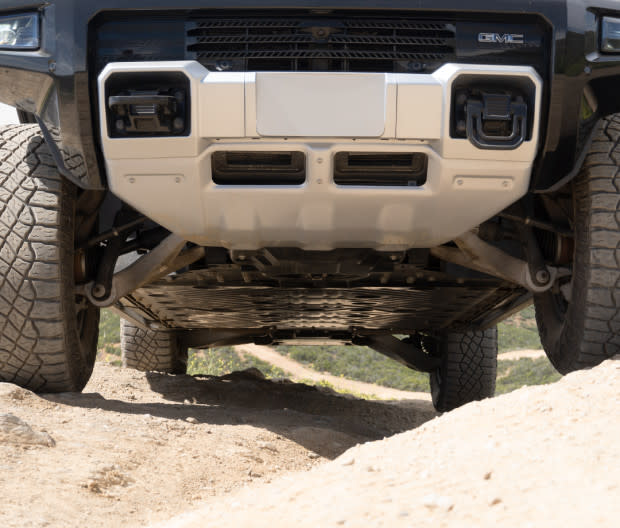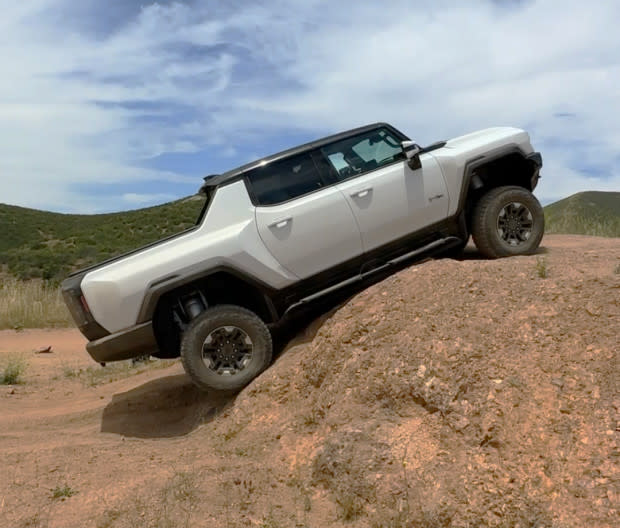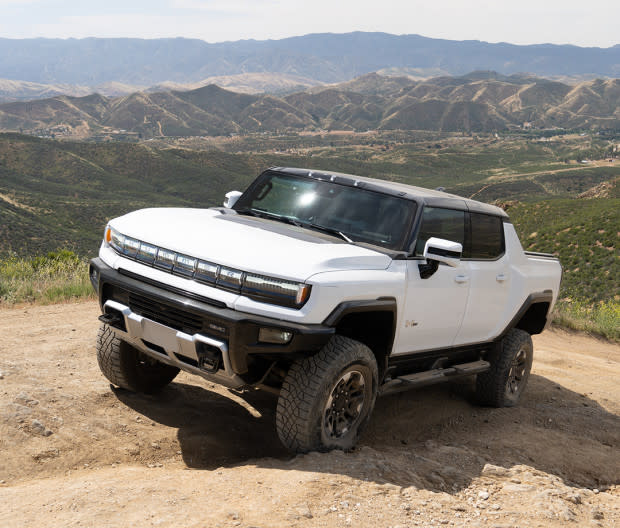First Ride: GM's Hummer EV Is Its Most Monstrous Electric Flex Yet
Try to imagine that first meeting at General Motors: stiff suits and a whiteboard, maybe a PowerPoint presentation or an iPad slideshow: “I want to bring back the Hummer,” someone says, before dropping the kicker. “But it’s gonna be fully electric.”
Chaos ensues. Surely not an electric version of the original H1, famously driven by Arnold Schwarzenegger in his prime, wider than wide, built for combat but sold to the general public as arguably the most rugged vehicle ever. Certainly not a revamp of the H2 or H3 parts-bin specials. Instead, a futuristic, aggressive truck to demonstrate the potential of electric power. Think about the potential customers GM still needs to convert. Maybe, just maybe, the seeds of such a harebrained plot can grow roots.
Regardless of how the lightbulb turned on, today Hummer lives again as an EV pickup truck and a forthcoming SUV under the GMC brand. Photos don’t—really, can’t—do the design justice in terms of size and presence. Up close and personal, the massive planar surfaces of the boxy pickup—especially when finished in Interstellar White—require a second take for eyeballs to balk, then refocus. Somehow, massive 35-inch tires look tiny beneath cavernous wheel arches, and the bed is actually much bigger than expected. Truly, this truck emerged in the 21st century with unmasked intentions to flex hard on Teslas, Rivians, and Priuses.
Sheer size is one thing but weight is another: Hummer’s GVWR sticker lists a max curb weight of 9,243 pounds, and the battery pack weighs 3,000 pounds alone. A Google search confirms the numbers. This might well be the biggest vehicle I’ve ever driven, other than an actual tank—which, ironically, I drove on the same day as a true military-spec Humvee, the foundation of the original consumer H1. But how well can an electric car with the aerodynamics of a brick and the heft of a dump truck actually drive? Well, therein lies the magic of effective engineering, a combination of power and refinement that left me equal parts dismayed and surprised by how much I enjoyed my time in GM's Hummer EV.

Michael Teo Van Runkle
You Must Crab Walk Before You Run
First things first. As soon as the monstrosity arrives outside my apartment in crowded Santa Monica, CA, I head straight out to find a wide-open parking lot where I can play with the famous “crab walk,” made possible by a four-wheel steering system and three electric motors. I fiddle with a bunch of buttons and knobs on the massive center console before a Google search reveals I need to hold down the four-wheel-steering button for an extended period of time while graphics on the 13.4-inch infotainment touchscreen “charge up” to the right amount. The screen lags a few seconds, and holding the button too long will turn off crab walk, but I eventually find the right interval.
Then, with a light turn of the steering wheel, I proceed to slalom around with the rear wheels turned to match the fronts at what GM says is up to a max of 10 degrees. Whipping back and forth trying to see how the system responds to purposefully playful inputs, the angle feels much more acute, creating a trippy sensation that transitions into borderline concern anytime I get anywhere near an object. Yanking the steering wheel a bit further will allow the big truck to truly turn, but in a wider arc rather than straight sideways (the only way to describe crab walking).
Related: Best Off-Roading Trips in America
Blasting back home, I try a few hard launches with traction control on and off. Rest assured, with a combined output of 1,000 horsepower and 1,200 lb-ft of torque powering all four wheels, Hummer EV Edition 1 scoots along just fine. But all that weight rears up, so the instantaneous jerk (the scientific term for rate of change of acceleration) never gets anywhere near a Tesla, Lucid, or even a Ford F-150 Lightning. Then again, everybody who drove the truck before me clearly did exactly the same thing, so the Goodyear Wrangler Territory mud-terrain tires arrive shredded, chunked up, and almost all the way down to the wear bars.
But all credit to GM for even shipping Hummer EV with mud-terrains! Most EVs, including Lightning, come equipped with eco-friendly touring tires to maximize their most important stat: range. Even with the gnarlier rubber, my Hummer shows up with 309 miles of range remaining—just enough, I figure, to head out and find some trails in the hopes of experiencing whether this monstrosity can live up to the aggressive engineering that so easily seems like posturing from afar.

Michael Teo Van Runkle
Super Cruising in an Electric Super Truck
I realize about halfway out of town to Rowher Flats OHV Area I can try Super Cruise, GM’s impressive semi-autonomous driving system that, on the Hummer, needs to handle a wide and heavy load. For lack of a better word, Super Cruise cruises along happily in typical LA traffic, no ping-ponging off lines in the road. It smoothly manages lane changes. We did experience one near-miss, though, when a (quite possibly drunk) old man cuts across four lanes of traffic on the freeway going around 12 miles an hour—a great chance to test whether ABS braking can actually haul down the Hummer. It does.
We arrive at the trailhead with 188 miles of range remaining and pull up a nifty Air Down Mode on the infotainment screen. It turns out, unlike the original, this Hummer does not have an active air system built into the axles and wheels or connected with the adjustable suspension’s compressor. Instead, I set a desired tire pressure and the TPMS cues ECU to honk when we reach that PSI. The added convenience while slowly dropping pressure for 35-inch tires is nice, since my automatic tire deflators already take forever hissing the air out of my personal truck’s narrower 31-inch tires.
To be entirely forthcoming, off-roading Hummer EV made me more nervous than any other vehicle I’ve driven in the dirt—even Lamborghini Huracan Sterrato, which I drove like a rally racer and legitimately jumped earlier this week. Those Goodyears, after all, would take quite a beating on the testing trail I typically drive trucks, and all the more so while trying to put down so much torque to move such a heavy vehicle. To make matters worse, GM only includes two spare wheels and tires as an option on the Hummer EV pickup—and not on this press loaner. I didn’t want to blow our day with a flat. Plus, what on Earth could possibly winch us out of a tricky situation if I ran out of talent?

Michael Teo Van Runkle
Aired Down for a Big Climb
I decide to air down to a middling 30 PSI in the hopes of maximizing the tires’ grip and compliance without ramping up the risk of pinch flats and debeading. On the steady fire road out toward Rowher’s first hard climb, I fiddle with the various drive modes, eventually landing on Off-Road with the air suspension set to Raised, which translates to 11.9 inches of ground clearance versus Normal’s 10.1 inches. The shocks also seem to soften, smoothing out the big boat’s ride along with the softer tires as we float over ruts and waves. Of course, at the first banked corner, I can’t help but give the accelerator pedal a bit of juice and we proceed to skirt around sideways a bit before the thought of blown tires again pierces my reverie.
Rowher’s harder trail typically features an initial obstacle that acts as something of a gatekeeper. If you can’t make it up those initial elephant steps, best turn around and find an easier route up the hill. Given the massive Southern California rainstorms since I last tested a truck at Rowher, though, I didn't know quite what to expect. Turns out someone graded the entry, so I power the Hummer up through some fairly mild undulations of hardpack with a top layer of soft dirt. With no locking diffs engaged, we make the climb without drama. But with no internal-combustion engine noises, I definitely hear, as well as feel, a fair amount of wheelslip (emphasized by a cloud of dust that wafts past shortly thereafter). OK, noted, maybe lockers next time.
A series of rutted aspects and sharp rocks dot our path up the hill, so I decide to try out at least the rear locker in hopes of avoiding some of that excessive wheelspin. Meanwhile, a conscious focus on smoother throttle modulation (if we can call it that) seems wise. But again, as the Goodyears scrabble to find grip, the wheels spin up and screech angrily while coping with so much weight. Maybe the front locker? A click of the piano key front locking diff button on the dash doesn’t turn on the light above. Neither does holding the button for as long as 10 seconds, nor pressing and holding the digital button on the infotainment screen display.
Related: The Best Side-by-Side UTVs of 2023
Oh well, onward and upward. As we climb farther, I notice Hummer’s traction control interjecting on power delivery—a necessity for all EVs, even those with a traction control defeat button, simply because instantaneous torque means that once tires slip, they spin up to max RPMs almost immediately. Off-roading a 9,000-pound electric truck clearly puts strain on GM’s programming, though, since the system essentially kills all power on the steepest sections, before finding grip and slowly delivering torque until we begin moving again. Giving too much juice only produces further wheelspins the system tries to combat, creating a rocking sensation as we lurch up the hill.
Yet, despite the ungodly weight and the obvious challenges of grip, Hummer EV ambles right up every single challenge with impressive balance, rarely putting a tire up in the air despite my growing confidence in the chassis. By the last few tough sections of terrain, I feel bold enough to take the YouTuber lines—despite my best intentions at reining in such exuberances in the hope of avoiding flats.
Near the top, I realize we still need to try actual Terrain mode! And while flipping around the (unlabeled) rotary dial on the center console, I also remember to switch into 4Lo. Talk about a lapse of judgment, which I could blame on the laggy infotainment screen and strange graphics interrupted by camera views that pop up while playing with the various drive modes and off-road functions. But really, I just forgot, deep in the zone trying to avoid flat tires.

Michael Teo Van Runkle
Extract Mode for Getting (Into and) Out of Trouble
Terrain mode changes the game entirely for the next few hundred yards, even if 4Lo seems less like a gearing reduction than simply a different map for throttle input. All of a sudden, the power delivery feels much more progressive, wheelspin decreasing noticeably, and the overall ride smoothes by a wide margin. Then again, the top few obstacles at Rowher are a lot easier than those below.
So, on the way down, I make another dubious decision to try out one last tough rock crawl, as a true test of 4Lo and Terrain mode, but also Hummer’s approach and breakover angles. I had already scoped out the underside of the Hummer while shooting some pics, so I know the front skid poses more for appearance sake and the rest of the skateboard-style battery wears minimal armoring. On this same rock, I once watched a Jeep Gladiator Rubicon with a two-inch Mopar lift kit scrape hard due to the long wheelbase—and by my eye, the Hummer looks pretty long, too.
To maximize our chances, I pump the air suspension up to the new Extract setting, a full six inches higher than Raised. Extract, as the name suggests, allows for maximum ground clearance in the hopes of getting out of gnarly situations—or more accurately, for me in this case, getting into and out of them. With our approach angle increased to a whopping 49.7 degrees, up from 41.5 degrees in Normal, the chances of high-centering on the skateboard battery packs should be that much lower.
Sure enough, Hummer makes it up and over that final boulder with just a bit more traction control-induced lag and wheelspin. Time to head home—not in Extract mode, though, which limits speed to only 12 miles per hour instead of dropping the ride height lower once the vehicle’s speed increases too high, since that might well happen at the worst possible moment. Smart.

Michael Teo Van Runkle
Calculating Real-World Range
Airing back up with the compressor I thankfully brought along requires removing a panel in the frunk to access Hummer’s 12-volt battery. As the tires slowly expand, I check our stats. All told, we used 54 miles of range to cover 9 miles off road, though most of that time was spent crawling uphill over tough terrain with the air conditioning and ventilated seats blasting.
In four total days with the truck, including that off-roading session, I used 193 miles of range driving 168 miles total—with plenty of hard launches, crab walking, and understeer drifting thrown in for good measure. Those figures seem pretty legit, especially for a hulk that weighs over 9,000 pounds. Due to the short loan period, I never needed to test the claimed charge time of 12 minutes to add 100 miles.
Of course, Hummer’s power and acceleration paired with such an absurd curb weight make for a borderline dangerous combination. The brakes kept me from crashing into that E90 BMW on the freeway, but any impact with any other vehicle would inevitably cause devastating damage. The requirements of building an EV that can truly manage 300 miles of range, with all the off-roading capability and a few gimmicky features like crab walk thrown in, may well have taken a step overboard.
But overboard has been the Hummer since day one—all the way back to the 1990s, when I sold Arnold Schwarzenegger a Christmas tree and he only had me strap it to his G-Wagen, not an H1. Of course, a forthcoming fully electric G-Wagen from Mercedes takes the gimmicks to a whole new level, if a video showing the boxy Benz doing a full tank turn reveals anything. I couldn’t even use crab walk in reverse to parallel park back home in Santa Monica, though the four-wheel steering definitely makes driving, parking, and off-roading through tight situations much easier. GM could probably install a tank turn function and fix the front locker with an over-the-air software update.
Related: U.S. Consumers Are Growing More Polarized About Electric Vehicles, Study Finds
A few other gripes I noticed just seemed out of place on a brand-new EV that costs upwards of $110,000. Namely, the frunk doesn’t close with the touch of a button (a problem for shorter people), the removable roof panels are transparent plastic tinted in a cheap shade of blue, and the four windows can wind down with a single press of a button but not up (my '97 Mitsubishi has one-touch windows, guys—come on). For those willing to shell out well into six figures for an obviously over-the-top and unnecessary vehicle like Hummer EV, whether equipped with two or three motors and in pickup or SUV form, lead times measured in years also sound like a serious bummer.
And yet, I can admit to enjoying Hummer EV much more than expected. Ever since childhood, I dreamt of taking a Hummer off-roading. I just never imagined that when the time came, it would be an EV. General Motors helped lead the vanguard toward today’s electrified automotive age, first with EV1, then with Bolt and Volt, but retrofuturism apparently now dominates the electrification conversation. Just don’t ask about the Cybertruck.
Still, by balling up so much power, so much presence, and so much capability, the new Hummer somehow manages to meet the exact excessive requirements that might someday convert those final holdouts still clinging to their diesel pickups, concerned about the rugged masculine image of the impending, inevitable electric future.
[From $110,000; gmc.com]
Solve the daily Crossword

